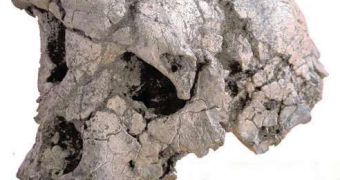When Toumai ("Hope of Life" in the local Goran language) was found in Chad in 2001, that changed all the theories about human evolution. This ape-like human lived in a forested area, sharing its habitat with other monkeys and apes. It probably spent some time in the trees and perhaps walked upright.
A French team has determined the age of Toumai at between 6.8 and 7.2 million years old. When the nearly-complete cranium, pieces of jawbone and teeth of Toumai were found, a vivid debate began.
Critics said that Toumai's brain capacity was too small and its small size (1.2 m or 4 ft tall) was that of a walking chimp. This species, named Sahelanthropus tchadensis by French researcher Michel Brunet, was just a vulgar ape.
But in a new study published in the "Proceedings of the National Academy of Sciences," the French researchers made 3D computer reconstructions of the skull of Toumai to show that it differed significantly from gorillas and chimps, and they also pointed that Toumai could walk bipedally, a hard task for our primate cousins. Genetic data show that humans and chimps split 4-5 Ma ago, but if Toumai is truly an early human, that split was much earlier.
The skull and the brain (320-380 cubic centimeters) were no larger than those of a chimp, but the short, flattened face, the pronounced superciliary Arch (unlike in chimps and humans, and pointing that the individual was a male), the less pushed forward mouth and jaws (than in the case of the apes) and the smaller and shorter canines, with a worn-down tip, show that the creature was not a chimp. The molars are larger than a chimp's, but smaller than in early humans, showing that it ate less fruits.
Perhaps the most interesting trait in the Toumai's skull is the foramen magnum, the aperture at the base of the skull, where the spine cord connects to the brain. It has an oval, not round shape like in chimps. Its shape and location points out that Toumai could walk in an upright position.
This face looks more modern than that of the Australopithecus afarensis, which lived 3.6 to 2.9 million years ago. Toumai shows that the last common ancestor of humans and chimpanzees did not look much like a chimp, as previously thought, and chimps could have evolved many of their traits after splitting from humans.
"The radiochronological data concerning Sahelanthropus tchadensis ... is an important cornerstone both for establishing the earliest stages of hominid evolution and for new calibrations of the molecular clock. Thus, Sahelanthropus tchadensis testifies that the last divergence between chimps and humans is certainly not much more recent than 8 Ma (million years ago.)", wrote Brunet.
Toumai also existed "very close in time to this divergence contrary to the unlikely 'provocative explanation,' which recently suggested a 'possible hybridization in the human-chimp lineage before finally separating less than 6.3 (million years ago)," wrote the authors.
The significance of Toumai is also given by the fact that his remains were discovered 2,500 km (1,500 mi) west of the Great Rift Valley, pointing that our early ancestors also roamed far wider from East Africa.

 14 DAY TRIAL //
14 DAY TRIAL //